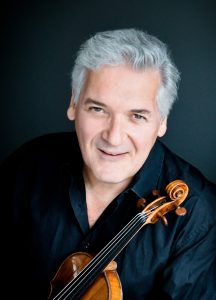
By Robert Croan
Johannes Brahms’s “Double” Concerto for Violin and Cello (in A minor, Op. 102), is a gnarly, dense work, not at all an easy romp for performers or listeners.
Under the deft fingers of violinist Pinchas Zukerman and his cellist wife, Amanda Forsyth, however — as it was in the season’s final concert by Symphony of the Americas (heard May 5 in Broward Center’s Amaturo Theater) — this challenging piece emerged animated and transparent. I’d seldom use the word “fun” to describe the music of the ultra-serious Brahms, but it was just that to see and hear this superstar duo go at it in their virtuoso solo passages.
It’s an unusual composition for its time (1887), harking back to an earlier century when it was common for concerti to feature multiple solo instruments in contrast with the full ensemble. Brahms created it, his last big orchestral work, for two friends — violinist Joseph Joachim and cellist Robert Hausmann — but particularly to appease Joachim, who had become alienated when Brahms took his wife’s side in their recent divorce proceedings.
Right from the start of SOTA’s rendition, cellist Forsyth asserted her stringent, incisive tone into the equation with a cadenza that caught the ear and kept the listener rapt until the woodwinds entered with their brief, soothing sonorities. Zukerman’s cadenza, in turn, was exquisitely sweet-toned, and when the two soloists played together in double stops, the effect approached the amplitude of a string quartet. No less exhilarating was the ability of these two to sound like a single instrument in passagework that traversed the gamut and made it hard to tell where one instrument left off and the other took over.
Artistic and music director Pablo Mielgo led the 55-member orchestra with authority and command. Brahms’s thick-voiced sonorities are a challenge for an orchestra that size, but the smaller numbers actually lent an unexpected degree of clarity. The lyrical Andante movement showcased the soloists’ rapport with the orchestral component, allowing the entire ensemble to dig into the Vivace finale, with its catchy “gypsy” tunes properly crisp and rhythmic. A standing ovation at the end was equally merited by the local musicians and the evening’s celebrated guest artists.
Although composed only seven years later than the Brahms opus, it would be hard to find a more dissimilar work than Debussy’s filmy, evasive Prelude to the Afternoon of a Faun, which followed after the intermission. It is to Mielgo’s credit that the orchestra adapted so well and so immediately to the contrast in styles. A musical counterpart to French Impressionist painting and poetry, this groundbreaking composition revels in its fragmented melodies, and tantalizes the ear with splashes of instrumental color. The 20th-century composer-conductor Pierre Boulez aptly called it the beginning of modern music.
The flute has the most prominent role, representing the nominal faun, and Emilio Rutllant’s rendition was fluent and accurate, though a little underpowered in balance with the full orchestral complement.
Ravel’s Boléro, which closed the concert as well as SOTA’s season, also features a single soloist from the orchestra: the snare drum player, who reiterates the underlying rhythmic pattern 169 times during the work’s approximately 15-minute duration. The late conductor Lorin Maazel often used it to test the attention and concentration of his players by making subtle, unexpected rubati (small tempo changes) in the course of any particular performance.
Mielgo placed timpanist Juan Manuel Lopez in full view of the audience, enhancing his role. More traditionally, the conductor maintained adherence to the dance rhythm, focusing on the work’s two overlying melodies — assigned to each instrument in turn — as well as the gradual crescendo that so brilliantly bursts its bubble in the final measures.